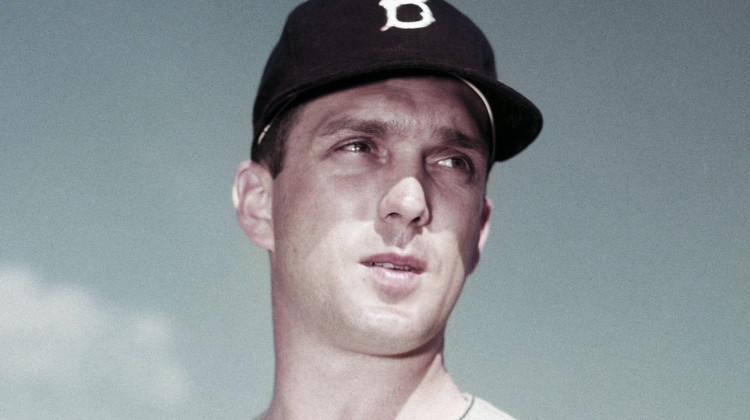By BETH HARRIS
Carl Erskine, who pitched two no-hitters as a mainstay on the Brooklyn Dodgers and was a 20-game winner in 1953 when he struck out a then-record 14 in the World Series, died Tuesday. He was 97.
Erksine died at Community Hospital Anderson in Anderson, Indiana, according to Michele Hockwalt, the hospital’s marketing and communication manager.
Among the last survivors from the celebrated Brooklyn teams of the 1950s, Erskine spent his entire major league career with the Dodgers from 1948-59, helping them win five National League pennants.
The right-hander had a career record of 122-78 and an ERA of 4.00, with 981 strikeouts.
Erskine had his best season in 1953, when he went 20-6 to lead the National League. He won Game 3 of the World Series, beating the Yankees 3-2 at Ebbets Field. He struck out 14, retiring the side in the ninth, for a record that stood until Dodgers ace Sandy Koufax got 15 in 1963. The Dodgers went on to lose in six games as the Yankees won their fifth consecutive championship.
Erskine’s death leaves the 88-year-old Koufax as the lone surviving Dodgers player from the 1955 World Series team.
Erskine was an All-Star in 1954, when he won 18 games.
He appeared in five World Series, with the Dodgers finally beating the Yankees in 1955 for their only championship in Brooklyn. He gave up a home run to Gil McDougald in the first inning of Game 4 and left after 3 2/3 innings. The Dodgers went on to win 8-5.
Carl Daniel Erskine was born Dec. 13, 1926, in Anderson, Indiana. He began playing baseball at age 9 in a local parks program.
After graduating high school in 1945, he was drafted into the Navy with World War II underway. A year later, Erskine asked the Navy recreation officer where he was stationed if he could play baseball. He was turned away, but a few weeks later, he was scouted by the Dodgers and discharged from military service.
He spent the next 1 1/2 years in the minors before making his major league debut on July 25, 1948. Erskine began as a reliever, going 21-10 during his first two seasons.
In 1951, he transitioned to the starting rotation and joined teammates Roy Campanella, Carl Furillo, Gil Hodges, Jackie Robinson and Duke Snider as one of the revered “Boys of Summer.”
In 1952, Erskine had a career-best 2.70 ERA and won 14 games. The following year, he led the NL with a .769 winning percentage, along with 187 strikeouts and 16 complete games, all career highs.
When teammate Don Newcombe was pitching in the ninth inning of Game 3 of the 1951 NL pennant with the New York Giants, Erskine and Ralph Branca were warming up in the bullpen.
On the recommendation of pitching coach Clyde Sukeforth, Newcombe was relieved by Branca, who then gave up the game-winning home run to Bobby Thomson in the famed “Shot Heard ’Round the World.”
Whenever Erskine was asked what his best pitch was, he replied, “The curveball I bounced in the Polo Grounds bullpen in 1951.”
Nicknamed “Oisk” by fans with their Brooklyn accents, Erskine pitched no-hitters against the Chicago Cubs in 1952 and the New York Giants in 1956.
Bobby Morgan preserved Erskine’s no-hitter against the Cubs with two brilliant fielding plays at third base.
“I made two super plays on swinging bunts where they just dribbled down the line and I fielded them one-handed and threw to Gil Hodges at first,” Morgan told The Oklahoman newspaper in April 2020.
Morgan, who died last year, said Erskine still thanked him years later whenever they spoke.
The Dodgers left Brooklyn for Los Angeles in 1957. Erskine didn’t enjoy being away from his family and he lasted just 1 1/2 more years with them. He pitched his final game in June 1959 and retired at 32.
Erskine returned to his hometown about 45 miles northeast of Indianapolis and opened an insurance business. He coached baseball at Anderson College for 12 years, and his 1965 team went 20-5 and won the NAIA World Series.
He also became active in the community and served as president and director at Star Financial Bank from 1982-93.
A 6-foot bronze statue of Erskine was erected in front of the Carl D. Erskine Rehabilitation and Sports Medicine Center to honor his accomplishments in baseball and as an Anderson resident. An elementary school built on land he donated is named for him. He was inducted into the Indiana National Baseball Hall of Fame in 1979.
In 2002, Erskine Street in Brooklyn was named for him.
His youngest son, Jimmy, was born with Down syndrome, which led Erskine to champion the cause of people with developmental disabilities. He wrote a book called “The Parallel,” about the similarities Jimmy and Erskine’s teammate Robinson shared in breaking down social perceptions. He was long involved with Special Olympics in Indiana and the Carl and Betty Erskine Society raises money for the organization.
Jimmy died last November at age 63, having outlived his prognosis by decades.
Erskine also authored the books “Tales from the Dodger Dugout” and “What I Learned From Jackie Robinson.”
He is survived by wife Betty and sons Danny and Gary and daughter Susan.
 DONATE
DONATE







 Support WFYI. We can't do it without you.
Support WFYI. We can't do it without you.